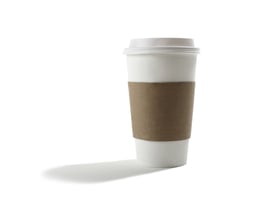 In a previous blog post, we discussed five key reasons why calcium carbonate filled polypropylene sheet is great for thermoforming applications. Among those reasons, was the sustainability benefits associated with using a filled PP product compared to a resin-only formulation. But evaluating the sustainability of a particular material is not complete until it is compared to alternatives available in the market. To provide a full-circle sustainability evaluation, a study conducted in 2016 by Franklin Associates for Heritage Plastics evaluates the environmental impact of a thermoformed CaCO3 filled PP cup compared to a popular alternative – the polycoated paper cup. Continue reading to learn more about the findings of this study:
In a previous blog post, we discussed five key reasons why calcium carbonate filled polypropylene sheet is great for thermoforming applications. Among those reasons, was the sustainability benefits associated with using a filled PP product compared to a resin-only formulation. But evaluating the sustainability of a particular material is not complete until it is compared to alternatives available in the market. To provide a full-circle sustainability evaluation, a study conducted in 2016 by Franklin Associates for Heritage Plastics evaluates the environmental impact of a thermoformed CaCO3 filled PP cup compared to a popular alternative – the polycoated paper cup. Continue reading to learn more about the findings of this study:
I1n our most recent blog post about calcium carbonate filled polypropylene sheet, we discussed some of the ways in which using CaCO3 filled PP can boost a products’ sustainability. Not only can the use of a calcium carbonate filled PP products allow for significant resin displacement, but a 40% CaCO3 filled PP sheet can generate Green House Gas (GHG) savings of approximately 23% - and this is before taking into consideration the increased productivity that calcium carbonate yields. But this is only one side of the story – in order to fully understand how sustainable a material or product is you must evaluate it against alternative materials that could conceivably be used as a substitute and perform the same function.
To do this, a study was prepared by Franklin Associates for Heritage Plastics titled “Life Cycle Assessment of Virgin Polypropylene, Polypropylene With Calcium Carbonate Concentrate, and Polycoated Paper Cup Systems." The purpose of the Life Cycle Analysis (LCA) study was to evaluate the environmental impact of a 32-oz thermoformed PP cup containing varying percentages of CaCO3 filler from Heritage Plastics. The PP cups submitted carried CaCO3 loading levels of 0%, 12.5%, 25% and 50%, and were compared to a corresponding size PE-lined paper cup, which is the product that has the largest market share for single-use cups of this size in the US. All cups in the baseline analysis were made from virgin materials. The results were aimed to provide information on the environmental benefits and tradeoffs associated with the lifecycle of these products, from cradle to grave, and identify the main contributors to the environmental impact of each product.
 Each product’s lifecycle was evaluated through four phases, starting from the extraction of the raw materials in nature, through fabrication and transportation, and culminating with post consumer disposal - assuming no recycling. Data collected throughout these four phases was then evaluated in an inventory and impact assessment to determine the global, regional and local environmental impacts of these cups. Categories of this assessment included total energy demand, non-renewable energy demand, solid waste by weight, solid waste by volume, water consumption, global warming potential, and ozone depletion potential, among others.
Each product’s lifecycle was evaluated through four phases, starting from the extraction of the raw materials in nature, through fabrication and transportation, and culminating with post consumer disposal - assuming no recycling. Data collected throughout these four phases was then evaluated in an inventory and impact assessment to determine the global, regional and local environmental impacts of these cups. Categories of this assessment included total energy demand, non-renewable energy demand, solid waste by weight, solid waste by volume, water consumption, global warming potential, and ozone depletion potential, among others.
Overall, the PP cup outperformed the polycoated paper cup, performing better in significant categories such as solid waste by weight, global warming potential, ozone depletion potential and total energy demand. At 0% and 12.5% loading, the PP cup performed significantly better than the polycoated paper cup in five of the ten categories. At a 25% loading, the PP cup performed better in six of the ten categories, and at a 50% loading, it performed better in seven of the ten categories. This shows that the addition of CaCO3 at higher loadings further improved the environmental profile of the product. The polycoated cup only outperformed the PP formulations in the non-renewable energy demand and solid waste by volume categories.
The results of this study are significant for plastics because they help to debunk the common misconception that plastics are not a sustainable solution, and furthermore, that other alternatives such as paper offer a more sustainable alternative. In addition, the findings prove that those with sustainability concerns can further improve the environmental profile of their plastic product by switching to a formulation with higher loadings of CaCO3 filler.
To learn more about the findings of this study contact our team today!
Not sure which polypropylene solution from Impact Plastics is right for your application? Check out our polypropylene material solutions:





